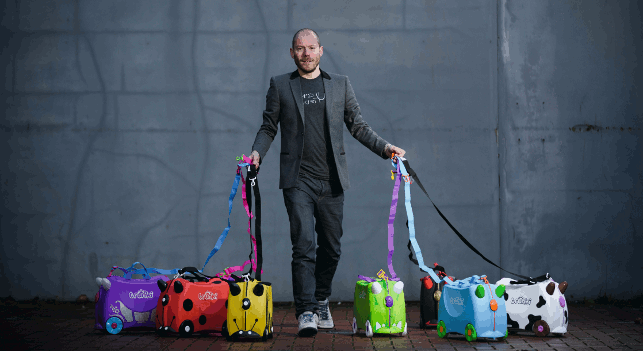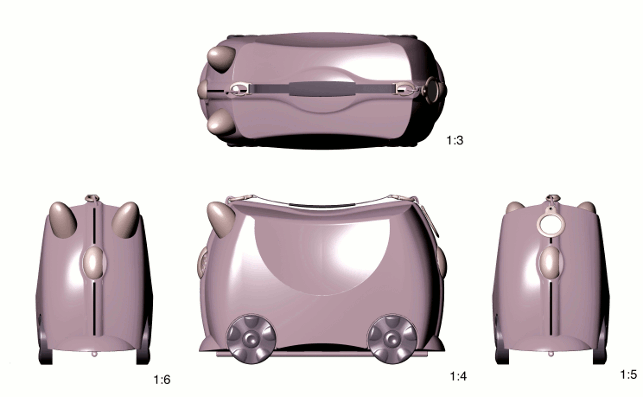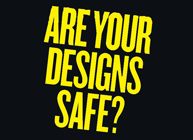Till recently European IP laws have been some of the strongest and most vehemently upheld in the world, yet a ruling in a single British case looks set to weaken them considerably.
Rob Law is the founder of British company Magmatic, best known as the designer of Trunki, a playful children’s suitcase that can be ridden on.
In the winter of 2012 Law attended a German trade show and spotted the Kiddee Case, a product by PMS International that he
thought looked like a copy of his Trunki.
The Kiddee Case appeared again at other trade shows, and Law wrote to the company to warn it that the Trunki design was a European Community Registered Design (CRD) and that he would be forced to take legal action.

Rob Law with a few of the Trunki cases in the range
The case was heard in the British High court in June 2013 where Magmatic won an injunction against PMS’ product being sold in Europe on the back of its CRD protection.
PMS lodged an appeal that rested on the interpretation of the grey scale CAD renderings filed by Magmatic as part of its CRD.
“They appealed on one element: that surface decoration should be taken into account when considering European Design Registration, which up until now has always felt it shouldn’t be,” recalls Law.
Law told DEVELOP3D that, at the appeal hearing the judges appeared unfamiliar with CAD renderings, and with this, the protection of his registered design began to break down.
The lead judge ruled that: “a distinct contrast in colour between the wheels… the strap… and the rest of the suitcase” is shown, and that this contrast should be taken into consideration when assessing the overall impression.”
Law explains: “All the big legal cases prior on design registration had been around line drawings. They [the judges] thought I must be one in a million who had registered CAD drawings [renderings] instead of line drawings.”
Law’s registration shows a Trunki case rendered in grey scale from six different angles, with the wheels a slightly darker shade to show they are a separate component. “In the case we tried to argue that it is the modern way of registering your product design,” says a clearly frustrated Law.
Law explains that on the grey scale rendering the wheels of the Trunki case were darker than the body, bringing PMS to argue that he had always intended the wheels to be darker than the body.
“Because their wheels are the same colour as the body that then means they get around the European Design Registration.” The court described the renderings as: “computer generated three dimensional images which show the suitcase from different perspectives and angles and show the effect of light upon its surfaces.”
Ultimately, the sophistication of the images led the Court of Appeal to determine it was wrong to discount all aspects of the CRD other than its shape, effectively limiting the amount of protection it offers. On this argument the court of appeal reversed the original verdict.
This decision could have a huge impact on the design industry. In theory it could mean design registration for a shape can be got around by simply adding surface decoration, like a print, pattern or marking, with little defence available to the designer.
The threat
The Trunki case is the first UK judgement in which a court has considered CAD renderings and found them to offer a narrower protection than the traditional line drawings that might have provided more protection.
The result of this case, if left to stand, could be cited as precedent in future IP law suits, meaning that a company accused of copying a design now stands much more chance of getting around the registered design if it was submitted as a render.
From Magmatic’s perspective the reversal of the verdict seems to have centred in some part around the judges’ lack of familiarity with computer aided design output.
Historic cases have always been judged on line drawings, but this is only because an alternative technology had yet to come to prevalence.
Technological advancements will always move faster than any statute and this raises real issues for the laws meant to protect and support the creative process.
It could also force designers to resort to outdated forms of submission to protect their work.
A look at the European Community Design Registry website submission process gives little guidance as to whether line drawings or CAD should be filed for an application as the ‘graphical representation’.
Starting from €350, a CRD lasts for five years and can be renewed a maximum of four times, giving its holder a potential 25 years of protection for relatively little outlay.
Currently there are around 460,000 CRDs, with 75,000 new applications being processed each year. It is estimated that nearly 65 per cent of all CRDs submitted last year were not presented as line drawings; potenitally leaving a vast number of designs less protected.
A competitive market
PMS is naturally excited by the decision. In a statement its managing director Paul Beverley said the case is a victory for the competitive market.
“The successful outcome of our appeal is also welcome confirmation that design registrations cannot be used to stop unpatented design concepts from facing fair competition from products that simply look quite different,” comments Beverley.
“If this were not the case, Hoover would be the only vacuum cleaner on the market and Apple would be the only tablet.”
Sincerest form of flattery?
For a designer the threat of a copycat product coming to market has always been present, and relatively easy to tackle.
“A successful product is always at risk of copying,” says Margaret Briffa, founder of IP law specialists Briffa.
“If the product is one made and supplied by a small business it is more likely that the copying will have serious consequences as most businesses lack the resources to tackle infringers who are intent on riding roughshod over a designer’s rights.”

The CAD renderings that Rob Law submitted with his registered design for the Trunki case
The costs of the legal process escalates as the litigation progresses, and although there are opportunities along the way to find a solution without ending up in court, taking a case to trial can cost £50,000.
“The winner will recover the majority but not necessarily all of its costs,” says Briffa. “After success at trial the question of compensation payable to the winner is also considered.
Briffa is one of many IP law firms in the UK that, on behalf of clients, tackles over 100 cases of IP infringement each year. Most settle on a commercial basis after an exchange of letters in which the designer asserts his or her rights. Yet the rise of manufacturers that solely exist to profit from producing low cost copies of designs could be set to grow should the ruling against Trunki stand.
If a product is copied and a commercial settlement is not reached the designer must consider whether to issue proceedings, asking a court to decide on the question of infringement.
The chances of a small enterprise or startup taking on over £50,000 of legal costs, with the odds increasingly stacked against them are slim.
Even with a reported annual turnover of £7m, Magmatic will be hit hard by losing the case even before any rival products have been sold. According to Law.
Beginning of the end?
The next step for Magmatic is to raise enough public support to garner a retrial in front of the Supreme Court, something only possible if deemed in the greater public interest.
Having formed the #ProtectYourDesign twitter campaign, Law has gathered a number of prominent designers to his
cause and is encouraging others to take to social media and write to their members of parliament to raise awareness.
“This issue needs to be raised as high as we can because it’s just unacceptable,” rallies Law.
“It essentially makes us a nation that you can copy and rip off products from rather than what we all believe we are, which is a nation of creative people who innovate and create new products.”
Tom Lawton – Designer and inventor
I feel for Rob. I have been ripped off in every way possible. It’s hard enough getting a product to market yet alone having to fight copycats to keep your market space.
I have to make a strategic decision about IP that exposes me to incredible risk (I do accept that comes with the territory) but let’s say, I have a clever design that hasn’t been proven in the market.

Do I start to patent it now only to face escalating costs that start in 18 months? Or do I take a flyer and attempt to get lightweight protection via a registered design, which will be published in the public domain almost immediately, allowing competitors to gain sight of what I am doing? Or do I do neither and focus on the quickest and best route to market? Or all the above?
At the start of my career I was advised that my product’s trade name would be my most valuable asset. It’s true, trademarks are easier to protect and enforce, but it’s impossible to create a brand without products to build it around.
So, for fear of just continuing an age old rhetoric, the whole system appears old fashioned and stacked in favour of bigger business, having a stifling effect on SME innovators like myself.
I think we need a new middle ground – something deeper than a registered design that perhaps can be extended into something like a patent, as a product evolves and business grows.
Something that acknowledges a designer’s original work beyond its exterior form. Something that a final year student, SME or independent inventor could actually afford to protect and maintain.
Dids MacDonald – ACID (Anti Copying In Design)
Design law is complicated even for IP lawyers and it is not helped that there is little clarity from registration authorities on what designers can or cannot rely on with their submissions.
UK designers are at a further disadvantage because, unlike our EU counterparts, if IP law fails them, they can turn to much stronger unfair competition laws. This, coupled with the fact that both UK and EU registration authorities do not examine design registrations, puts any designer at an unfair disadvantage.

At least if they were examined, formative feedback could evolve into better guidelines as to what is and isn’t protected.
It’s time for clarity and ACID has written a submission seeking re-examination to the Supreme Court not only for Trunki but for the design community as a whole.
It’s good that so many designers have united to support Trunki’s designer Rob Law because the reality for many lone, micro and SME designers who suffer from design theft is that legal redress is a dream.
I fully support the #ProtectYourDesign campaign and hope that the combination of grass roots support with a positive response from the Supreme Court will provide the right answers to support UK design talent and clarify registration rules for the future.
IP ethics, compliance and respect should be in the DNA of all successful companies, it’s time that those who espouse the principles of CSR should stand up and be counted!
Kevin Quigley, owner of Quigley Design
Like designers, you get a different opinion from every lawyer. The basics can be found through simple online research. Maybe designers don’t like doing it but for me it’s part of the business of design and the service we offer customers.
Also, how many professional designers – in-house and consultancy – can honestly say they have never done what Kiddee Case have done? Perhaps not quite as blatantly but for many the starting point of a design project is looking at what’s out there and designing around protections that are in place. Perhaps this is the elephant in the room in the design industry?

I have looked at the competitor product to Trunki and (this won’t be popular) in my opinion it is sufficiently different to get around Design Registration status – the shape, the details, are all “sufficiently” different (when viewed by a layman). Yes of course it is very similar but it is not a direct copy.
The value of the Trunki product or brand is in the idea that the child can ride on the case and perhaps the advice they should have had was to patent this idea rather than apply for the (much cheaper) design registration.
To some extent there will be no winners now – the cat’s out the bag, more copies will tooled up right now and the lawyers are salivating. I’m not going to subscribe to the view that this ruling affects thousands of British designers. That is rubbish. Our customers are already affected by this.
Like all patent related cases the better the quality of the original application, the better the likely outcomes will be.
Maxine J Horn – Creative Barcode, IP Protection
I believe the Court of Appeal were wrong to overturn the ruling of the High Court which found in favour of Magimatic (Trunki).
It predominantly based their decision on colour and surface pattern aesthetics to reach their conclusion that the Kiddee Case would not give the same overall impression to the consumer as the ride-on Trunki,.

Interestingly, Paul Beverley of Kiddee Case attempted to side-step the allegations of copying by stating that he himself did not create the artist impression nor the design or prototype as he is neither an artist nor designer. Ironically, had he been a designer the likelihood is he would not have infringed another designers’ product.
Does this present an immediate loophole in the tenaciously fought and recently won change to the IP Bill where blatant copying of a registered design is to be subject to criminal sanctions? Who will be prosecuted – the person or business commissioning and directing the copy or the person physically undertaking the copying?
A Community Registered Design in today’s fast moving market does not remain static it continuously evolves whilst remaining true to the core innovation which opens up new markets and sectors.
Overall, the Court of Appeals’ decision strikes a bitter blow to UK product designers if ergonomics, features, shape and overall impression of a new design can be superseded where colour and surface pattern become judged as the key differentiation factors impacting on consumers.
Alastair Swanwick – MD, Innovate Product Design
The Court of Appeal has looked at the way the luggage was depicted and decided that some features looked more important than others.
This could have gone either way, but the decision is a clear reminder of the importance of a good understanding of your design.

We always recommend registering line drawings from the final CAD model for our product design clients, if they are concerned only with form. Line drawings put everything on the same level of importance and the CAD model makes it easier to change angles, remove superfluous parts, and isolate or exaggerate features.
The final design should be already nailed and hopefully feedback should indicate the relative importance of the features.
In product design it is common sense that all features are viewed in the context of the overall design, commercial factors and the wider field. So if features of the design stand out, for instance colours or texture, these features could of course be argued to be important to the design.
This seems to be what the Court was saying in relation to the law about how designs are registered and this would seem to fit with how things should be.
This just reiterates the situation that in relation to registered design applications it is vital that an accurate and well-considered representation of the design is filed.
Tom Kurke – Mentor, The Startup Factory
Many commentators have said the practical takeaway guidance from the Court of Appeals decision is that those seeking protection via a CRD should generally avoid surfaced 3D representations in their CRD filings, and instead using wireframes.
The logic is that if only wireframes are used, then surface markings, colour, etc. are irrelevant in a CRD infringement analysis.

Since at least one part of the Court of Appeals decision focused on the purposeful difference in the wheel colour chosen by Magmatic, that would have been irrelevant if they had used wireframes.
I am certainly no expert in UK law, nor that relating to CRD registrations, but I do not believe that this case represents bad law, as much as it does a bad set of facts for the Plaintiff, Magmatic.
If Magmatic had submitted wireframes as part of their CRD, then PMS would have most certainly first claimed that the CRD itself was invalid because it wasn’t novel or possess enough individual character to warrant protection – the very things that colours, surface markings, lettering, etc. can bring to a simplified shape which make it more unique and protectable as a CRD.
It could be argued that many of the design elements were functional, and therefore not protectable (e.g. cases need wheels, they have straps, clasps, etc.) – particularly if depicted as a wireframe.
Ultimately though, if Magmatic had submitted wireframes for its CRD, wouldn’t it still have looked like an “horned animal” as opposed to an “insect” to the Court?
Intellectual Property laws in the UK
Revealed in government reports to be costing UK businesses an estimated £9.2 billion annually, intellectual property theft is not a problem to be taken lightly.
UK laws regarding product design have been reinforced, making copying a design a criminal offence, enabling manufacturers and designers to protect their innovation.
Protections available for a physical design slightly vary: a new invention can be patented, giving the owner the right to prevent others from producing it without permission.
A registered design grants exclusive rights for the look and appearance of the product – predominantly the external form — and stops replicas being produced in the area it is filed for, usually referring to more aesthetic design.
ipo.gov.uk
We asked Margaret Briffa, founding partner of Briffa IP Lawyers, for her advice on how to secure and protect your IP
Consider protection as you go along — When developing products think about the rights you can secure and register designs as line drawings with the UK Intellectual Property Office or European Design Registry
Extend your protection — Within six months of the first filing extend your protection to other countries. After six months your design will not be extendable so this deadline is important
Paper trail — Keep records of your product development: they are useful to show your rights in ‘unregistered designs’ and also can help show where copying has taken place
Research the offender — If you spot a copycat product buy one, find out as much as you can about the company making and selling it, and asses how the copy will impact on your market
Take legal advice — Design law can be incredibly complicated and you can benefit from the experience of those who deal with such situations on a regular basis 
British designers in Intellectual Property battle
Default






